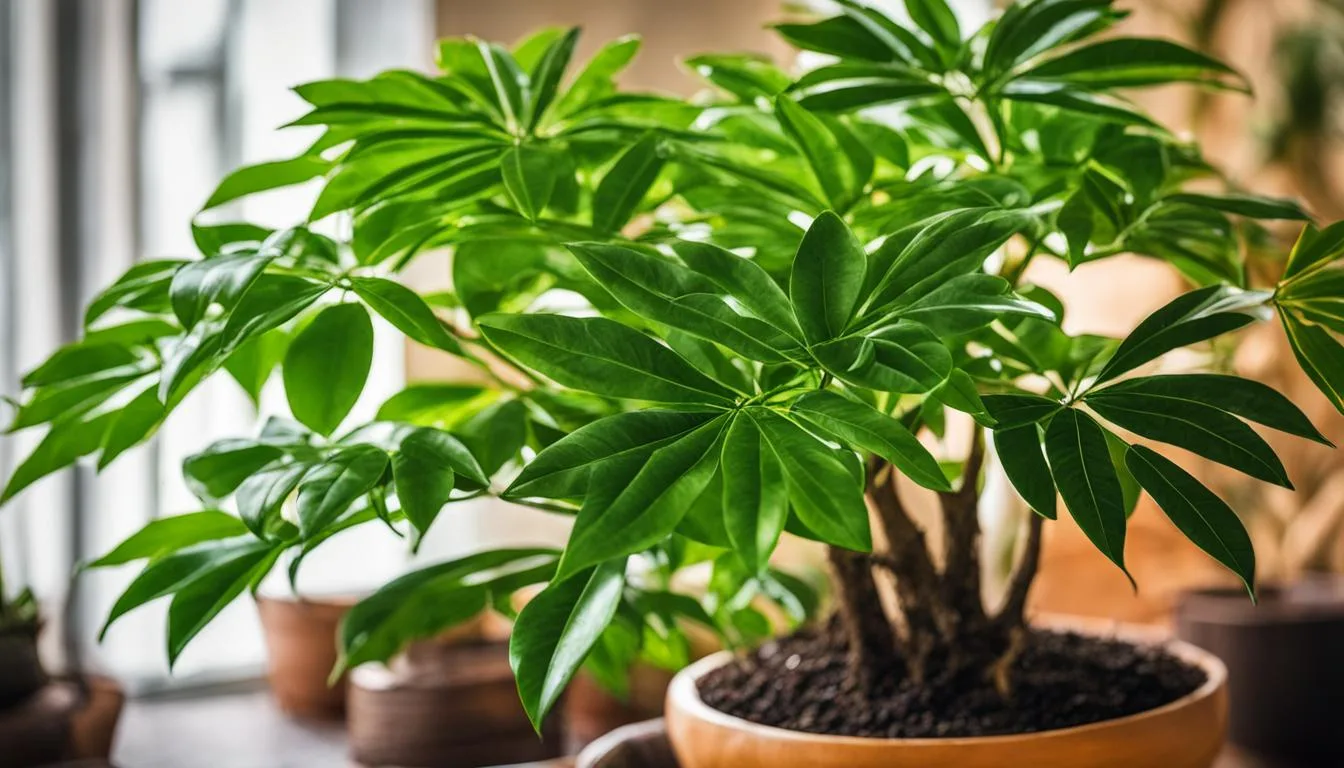
Welcome to my guide on Schefflera care! If you’re a plant lover looking to bring some greenery into your home, Schefflera plants are a fantastic choice. These tropical houseplants can thrive in the comfort of your own home, adding a touch of vibrancy to any indoor space.
In this article, I’ll provide you with valuable plant care tips and insights on how to successfully cultivate Schefflera plants in your home environment.
Schefflera plants, including the Schefflera actinophylla and Schefflera arboricola varieties, are native to tropical regions. Despite their origins, these plants can be grown indoors in cooler climates, although they rarely produce flowers in this setting.
It’s important to note that while Schefflera plants are beautiful, all parts of the plant are mildly toxic to humans and more toxic to pets, so exercise caution when handling and keep them out of reach of curious pets and children.
Key Takeaways:
- Schefflera plants are popular tropical houseplants that can thrive in the home environment.
- They have long, shiny leaves that resemble umbrellas, adding a vibrant touch to any space.
- Schefflera plants can be grown indoors in cooler climates, but rarely produce flowers in this setting.
- It’s important to note that all parts of the Schefflera plant are mildly toxic to humans and more toxic to pets.
- Exercise caution when handling Schefflera plants and keep them out of reach of pets and children.
Schefflera Plant Overview
Schefflera, also known as the umbrella plant or umbrella tree, is a genus of tropical plants in the Araliaceae family. There are two common species used as houseplants: Schefflera actinophylla and Schefflera arboricola.
Schefflera actinophylla has larger leaves and can grow up to 25 feet tall outdoors, while Schefflera arboricola has smaller leaves and reaches a height of around 6 feet indoors. These plants get their name from the long, shiny leaves that resemble umbrellas, adding a vibrant touch to any indoor space.
Schefflera plants thrive in bright, indirect light and prefer slightly acidic soil with good drainage. They are native to tropical regions but can be grown indoors in cooler climates.
It’s important to note that they rarely produce flowers when grown indoors. These plants are also mildly toxic to humans and more toxic to pets, so caution should be exercised when handling them.
To summarize, Schefflera plants, also known as umbrella plants, are tropical houseplants that come in two common species: Schefflera actinophylla and Schefflera arboricola. They have large, shiny leaves that resemble umbrellas and can grow to different heights depending on the species.
These plants prefer bright, indirect light and slightly acidic, well-draining soil. While they can adapt to indoor environments, they rarely flower indoors. It’s important to handle them with care as they are mildly toxic.
Mature Sizes of Schefflera Plants
| Schefflera Species | Mature Height (Indoors) | Mature Height (Outdoors) |
|---|---|---|
| Schefflera actinophylla | Up to 6 feet | Up to 25 feet |
| Schefflera arboricola | Around 6 feet | Not suitable for outdoor growth |
Schefflera Light and Placement: Creating the Perfect Environment for Your Indoor Plants
When it comes to the care of Schefflera plants, providing the right light and placement is crucial for their growth and overall health. These tropical houseplants thrive in bright, indirect light, making placement an important consideration in your home.
To meet the Schefflera’s light requirements, choose a location with lots of filtered sunlight. Placing your plant near windows or under a patio cover will allow it to receive the optimal amount of light.
However, it’s essential to avoid direct, full sunlight as it can scorch the leaves. If you notice your plant becoming leggy or floppy, it may be an indication of insufficient light. In shadier spots, growth may be slower, and leaves may be smaller.
Creating the perfect environment for your indoor plants involves finding the right balance of light and shade. Schefflera plants thrive in bright, indirect light, providing them with the energy they need to grow and flourish.
By carefully considering their light requirements and finding the ideal placement within your home, you can ensure that your Schefflera plants thrive and add a touch of vibrant beauty to your indoor space.
| Light Requirement | Placement Tips |
|---|---|
| Bright, indirect light | Near windows or under a patio cover |
| Avoid direct, full sunlight | Can scorch the leaves |
| Leggy or floppy growth | Indication of insufficient light |
Watering and Humidity for Schefflera
Proper watering and humidity levels are essential for the health and well-being of Schefflera plants. By understanding the watering requirements and maintaining optimal humidity, you can help your Schefflera thrive in the home environment.
Watering Frequency
Schefflera plants should be watered regularly during the growing season. However, it’s important to allow the soil to dry out between waterings to prevent overwatering and root rot. The frequency of watering can vary depending on various factors such as the size of the plant, pot size, and environmental conditions.
As a general guideline, check the moisture level of the soil by inserting your finger about an inch deep. If the soil feels slightly dry, it’s time to water your Schefflera. Deep watering is recommended to ensure that the water reaches the root zone. Water the plant thoroughly until water starts to drain out of the bottom of the pot.
Maintaining Soil Moisture
While Schefflera plants prefer slightly moist soil, it’s important not to let the soil become waterlogged. Overwatering can lead to root rot and other issues. To maintain optimal soil moisture levels, provide adequate drainage by using pots with drainage holes and a well-draining potting mix.
Additionally, consider the environmental conditions in your home. Factors such as humidity levels, temperature, and air circulation can affect how quickly the soil dries out. In drier environments, you may need to water your Schefflera more frequently.
Plant Humidity
Schefflera plants prefer moderate humidity levels between 40-60%. While they can tolerate average room humidity, higher humidity levels can help promote lush and healthy foliage.
To increase humidity around your Schefflera, you can mist the leaves regularly or place the plant on a tray filled with water and pebbles. The water will evaporate, increasing the moisture level around the plant.
By understanding the watering needs of Schefflera plants and maintaining appropriate humidity, you can provide the ideal growing conditions for these tropical houseplants. Remember to monitor the moisture level of the soil and adjust your watering schedule as needed. With proper care, your Schefflera will thrive and add life and beauty to your indoor space.
Fertilizing and Feeding Schefflera
Proper fertilization is essential for the healthy growth of Schefflera plants. Providing the right nutrients can help promote vibrant foliage and overall plant vigor. There are different fertilization methods to consider, including liquid fertilizers and slow-release pellets.
Liquid Fertilizer: Liquid fertilizers are a convenient and effective way to feed Schefflera plants. They can be applied directly to the soil or mixed with water and applied during regular watering sessions.
It’s important to follow the instructions on the fertilizer packaging for the correct application rates. Generally, liquid fertilizers should be applied every two weeks during the growing season.
Slow-Release Pellets: Slow-release pellets are another option for fertilizing Schefflera plants. These pellets release nutrients gradually over time, providing a steady supply of nourishment.
They can be inserted into the soil during repotting or applied to the top layer of the soil. Slow-release pellets typically last for several months, reducing the frequency of fertilization required.
When choosing a fertilizer, look for one specifically formulated for houseplants or tropical plants. These fertilizers contain the necessary balance of nutrients to support Schefflera’s growth.
It’s important to remember that over-fertilization can be harmful to the plant, so always follow the recommended dosage and adjust based on the plant’s response. Regular fertilization, along with proper watering and light conditions, will help your Schefflera thrive and maintain its beautiful appearance.
| Fertilizer Type | Application Method | Frequency |
|---|---|---|
| Liquid Fertilizer | Direct application to soil or mixed with water | Every two weeks during the growing season |
| Slow-Release Pellets | Inserted into soil or applied to top layer | Lasts several months |
Schefflera Pruning and Propagation: Maintaining and Multiplying Your Plants
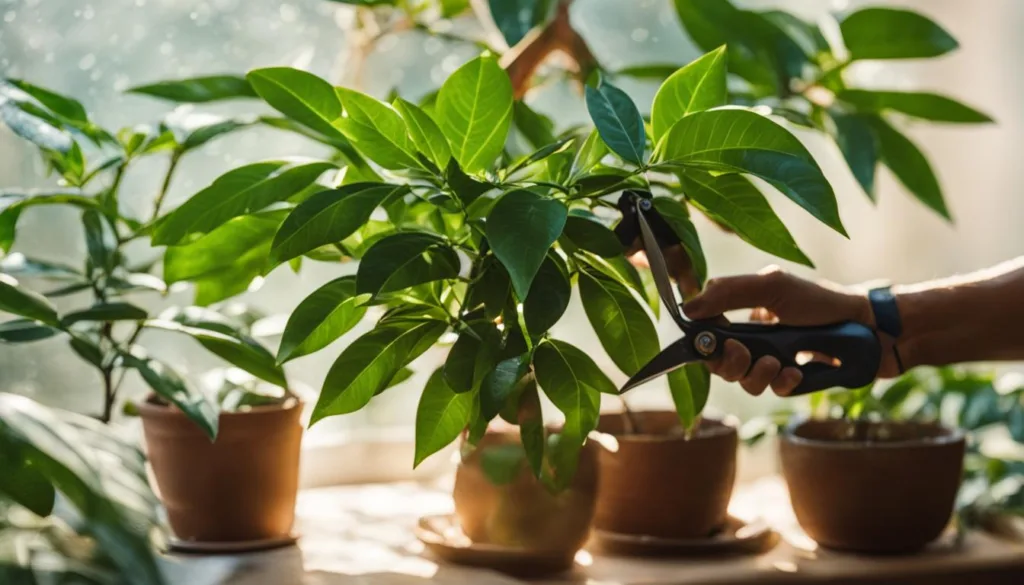
Pruning is an essential part of Schefflera plant care, as it helps maintain the plant’s shape and encourages bushier growth. To prune your Schefflera, start by removing any dead or damaged leaves or branches. This will not only improve the plant’s appearance but also prevent the spread of diseases. Additionally, if your Schefflera is becoming leggy or sparse, you can trim back the stems to promote fuller growth.
When pruning Schefflera, use clean and sharp pruning shears to make clean cuts. Avoid cutting too close to the main stem, as this can leave a large wound that may take longer to heal. Instead, aim to make your cuts just above a healthy bud or leaf node. Regular maintenance pruning, combined with occasional rejuvenation pruning, can help keep your Schefflera healthy and attractive.
In addition to pruning, Schefflera plants can also be easily propagated through stem cuttings. To propagate your Schefflera, select a healthy stem with several leaves and use clean, sharp scissors to make a clean cut just below a leaf node.
Remove the lower leaves from the cutting, leaving a few at the top. Dip the cut end into rooting hormone to promote root development, then plant the cutting in a container with well-draining, moist potting soil.
Place the container in a warm and bright location, and mist the cutting regularly to maintain humidity. With appropriate care, your stem cutting should develop roots within a few weeks and can be transplanted into a larger pot once established.
Pruning and Propagation Tips for Schefflera
| Pruning | Propagation |
|---|---|
| Remove dead or damaged leaves and branches | Select a healthy stem with several leaves |
| Trim back leggy or sparse stems | Cut the stem just below a leaf node |
| Use clean and sharp pruning shears | Dip the cut end into rooting hormone |
| Avoid cutting too close to the main stem | Plant the cutting in well-draining soil |
| Regular maintenance pruning keeps plants healthy | Keep the cutting in a warm and bright location |
| Rejuvenation pruning for older plants | Mist the cutting to maintain humidity |
Common Issues and Pests for Schefflera
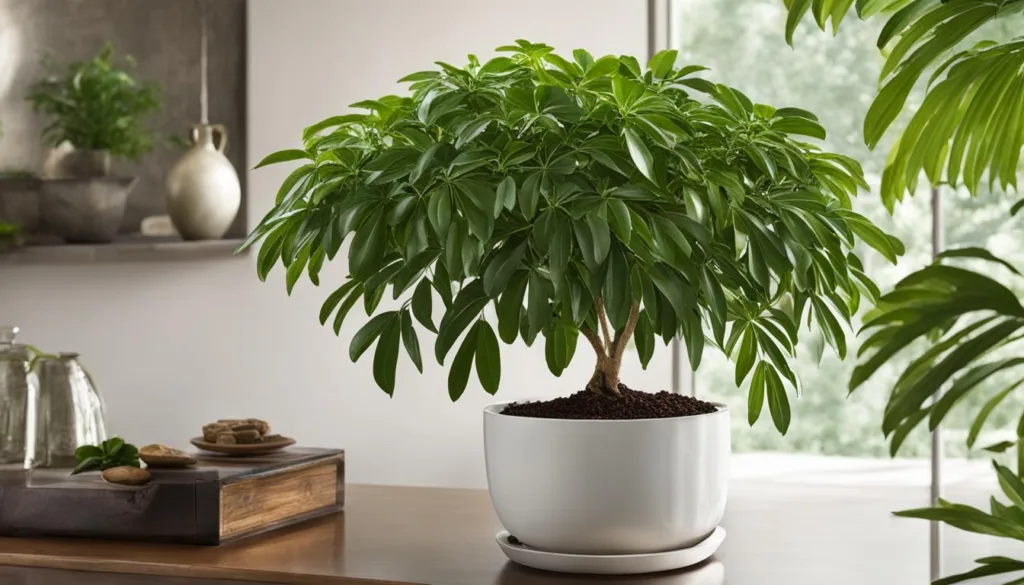
Schefflera plants, like any other houseplants, can face certain issues and be susceptible to pests. Being aware of these common problems and taking preventive measures can help ensure the health and vitality of your Schefflera plant.
Pests
Schefflera plants can be attacked by various pests, including aphids, mealybugs, spider mites, and scale insects. These pests can cause damage to the leaves and stems, leading to stunted growth and overall decline of the plant.
- Aphids: These small, soft-bodied insects feed on the sap of the plant, causing yellowing of leaves and distortion of new growth. Insecticidal soap can be used to control aphids.
- Mealybugs: Mealybugs are small, white, cottony insects that often infest the leaf axils and undersides of leaves. They can be removed by gently wiping the affected areas with a cotton swab dipped in rubbing alcohol.
- Spider mites: These tiny pests can cause yellowing and stippling of leaves. They are often found on the undersides of leaves and can be controlled by regularly spraying the plant with water to increase humidity.
- Scale insects: Scale insects appear as small, raised bumps on the stems and leaves. They can be removed by gently scraping them off the plant or using an insecticidal soap.
Leaf Spot Diseases
Schefflera plants can also be susceptible to leaf spot diseases, such as bacterial leaf spot and alternaria leaf spot. These diseases are characterized by the development of dark, water-soaked spots on the leaves.
To prevent leaf spot diseases, it’s important to avoid overhead watering and water the plant at the base. Watering in the evening can also help prevent the spread of these diseases. If leaf spot diseases develop, applying a copper fungicide can help control the spread.
| Pest/Disease | Description | Prevention |
|---|---|---|
| Aphids | Small, soft-bodied insects that feed on sap | Use insecticidal soap |
| Mealybugs | Small, white, cottony insects that infest leaf axils and undersides | Remove with rubbing alcohol |
| Spider mites | Tiny pests that cause yellowing and stippling of leaves | Increase humidity by spraying with water |
| Scale insects | Small, raised bumps on stems and leaves | Scrape off or use insecticidal soap |
| Leaf spot diseases | Dark, water-soaked spots on leaves | Avoid overhead watering, use copper fungicide |
Schefflera Temperature and Indoor Environment: Creating the Perfect Tropical Care
Creating the optimal temperature and environment is crucial for successfully caring for your Schefflera plant. These tropical beauties thrive in warm temperatures between 60 and 75 degrees Fahrenheit.
It’s important to provide a stable indoor environment and avoid exposing the plant to extreme temperature conditions, as Schefflera plants do not tolerate sudden temperature changes or exposure to drafts or dry heating vents.
If the temperature drops below 60 degrees Fahrenheit, the plant may start to drop leaves quickly, indicating distress.
To ensure your Schefflera plant thrives, place it in a location with lots of bright, indirect light. Schefflera plants prefer filtered sunlight, such as near windows or under a patio cover.
Avoid placing them in direct, full sunlight, as this can burn the leaves. If your plant becomes leggy or floppy, it may not be receiving enough light.
In shadier spots, the growth may be slower and the leaves may be smaller. Finding the right balance of light and temperature is critical to the health and vitality of your Schefflera.
Caring for Your Schefflera in a Tropical Environment
When creating an indoor environment for your Schefflera, it’s important to consider the humidity levels. These tropical plants prefer moderate humidity between 40% and 60%.
Regularly spraying the leaves with water can help increase humidity around the plant. Additionally, placing the plant on a tray filled with water and pebbles can provide added moisture. If you live in a dry climate, using a humidifier can help create the ideal tropical conditions for your Schefflera.
| Temperature | Light | Humidity |
|---|---|---|
| 60-75 degrees Fahrenheit | Bright, indirect light | Moderate humidity (40-60%) |
By maintaining the optimal temperature, light, and humidity conditions, you can create a tropical paradise for your Schefflera plant.
Remember to avoid exposing it to extreme temperature changes, provide filtered sunlight, and offer adequate humidity. With the right care and attention, your Schefflera will thrive and add a touch of tropical beauty to your indoor space.
Schefflera Repotting: Promoting Healthy Plant Growth
Repotting schefflera plants is an essential part of their care routine, as it promotes healthy root growth and ensures optimal plant health. When the plant’s root system has outgrown its current container or the soil has become compacted, it’s time to consider repotting.
To repot a schefflera, choose a pot that is one size larger than its current container and has drainage holes to prevent waterlogging. Good soil drainage is crucial for the plant’s overall well-being. Use a well-draining potting mix that promotes airflow to the roots and prevents water from sitting around the roots for too long.
The frequency of repotting depends on the growth rate and size of the schefflera. On average, repotting every 2-3 years is sufficient. However, if the plant is growing rapidly or becoming root-bound, it may need more frequent repotting. It’s important to monitor the plant’s growth and check the roots periodically to determine when repotting is necessary.
| Signs It’s Time to Repot Schefflera | Repotting Frequency |
|---|---|
| The plant is root-bound, with roots circling around the container. | Every 2-3 years |
| The soil is compacted and doesn’t provide adequate drainage. | When the plant outgrows its current container |
| The plant’s growth rate is rapid and requires more space for the roots. | More frequent repotting may be necessary |
During the repotting process, gently tease the roots apart to encourage outward growth. Remove any damaged or rotting roots. Place the schefflera in the new pot, adding fresh potting soil around the root ball, and firm it gently. Water the plant thoroughly after repotting to settle the soil and provide a healthy start for the schefflera in its new container.
Similar Plants to Consider
If you’re looking for alternative houseplants similar to Schefflera, one great option is the Money Tree (Pachira aquatica). Like Schefflera, Money Tree has an attractive appearance and can add a bushier touch to your indoor space.
It is commonly grown as an indoor houseplant and is known for its resilience and appealing foliage. In USDA zones 10 to 12, Money Tree can also be grown outdoors.
When considering alternative plants, it’s important to choose one that suits your specific preferences and care requirements. If you appreciate the vibrant green leaves and tropical aesthetic of Schefflera, other plants like Rubber Plant (Ficus elastica) and Swiss Cheese Plant (Monstera deliciosa) may also be appealing options. These plants share similar care needs and can thrive in the home environment.
Money Tree (Pachira aquatica)
The Money Tree, also known as the Malabar chestnut or Guiana chestnut, is a popular choice for indoor gardening. It features a braided trunk and shiny, palmate leaves that resemble a hand with five fingers.
Money Tree is believed to bring good luck and prosperity, making it a popular gift choice. It is relatively low-maintenance, requiring bright indirect light and regular watering.
| Plant | Light Requirements | Watering Frequency | Care Difficulty |
|---|---|---|---|
| Schefflera | Bright indirect light | Allow soil to dry out between waterings | Moderate |
| Money Tree | Bright indirect light | Water when the top inch of soil is dry | Easy |
| Rubber Plant | Bright indirect light to partial shade | Water when the top inch of soil is dry | Moderate |
| Swiss Cheese Plant | Bright indirect light to partial shade | Water when the top inch of soil is dry | Moderate |
These plants, including the Schefflera, offer lush foliage and can be excellent choices for those looking to bring a touch of nature into their indoor spaces.
Additionally, they are relatively easy to care for, making them suitable for both beginner and experienced gardeners alike. Before choosing a plant, be sure to consider factors like the available light in your home and your ability to provide the necessary care. With the right plant selection and care, you can create a vibrant and thriving indoor garden.
Schefflera Care FAQs
As an indoor plant, Scheffleras have a lifespan of 25 years or more, while outdoor specimens can live for decades. To ensure the best growth and health for your Schefflera, it’s important to provide the right indoor placement.
These plants thrive in locations with plenty of bright, indirect light. Place your Schefflera near windows or under a patio cover to provide ample filtered sunlight. Avoid placing it in direct, full sunlight as it can cause leaf burn.
For those seeking alternative plants similar to Schefflera, the money tree (Pachira aquatica) is a popular choice. This plant, with its attractive foliage, can add a bushier appearance to your indoor space.
Money trees are hardy in USDA zones 10 to 12 and are commonly grown as houseplants. Consider adding a money tree to your collection if you enjoy the appearance and care requirements of Scheffleras.
Optimal Planter and Care Instructions for Schefflera
When it comes to choosing the right planter for your Schefflera plant, there are a few key factors to consider. Firstly, ensure that your planter has proper drainage.
Scheffleras prefer well-draining soil, so it’s important that water can easily escape through the bottom of the pot. You can achieve this by placing a layer of pebbles or broken pottery in the bottom of the planter before adding the potting soil.
Speaking of soil, opt for an organic potting mix that is formulated for indoor plants. This will provide the necessary nutrients and ensure good drainage. Avoid heavy garden soils, as they can retain too much moisture and lead to root rot.
Now let’s talk about watering. Scheffleras like to be evenly moist but not soggy. Water your plant thoroughly, allowing the excess water to drain out of the bottom of the pot.
Then, wait until the top inch of soil feels dry before watering again. This usually means watering once a week, but you may need to adjust the frequency depending on the temperature and humidity in your home.
If you prefer a low-maintenance option, you can consider using a self-watering pot for your Schefflera. These pots have a reservoir that slowly releases water to the roots, ensuring consistent moisture levels. Just make sure to monitor the reservoir and refill it as needed.
FAQ
How long can Schefflera plants live?
Outdoor Scheffleras can live for decades, while indoor specimens can live for 25 years or longer.
What light conditions do Schefflera plants prefer?
Schefflera plants should be placed in a location with lots of bright, indirect light.
Are there any alternative plants similar to Schefflera?
Yes, you can consider the money tree (Pachira aquatica) as an alternative.
How often should I water Schefflera plants?
Schefflera plants should be watered weekly, allowing the soil to dry out between waterings.
How should I maintain humidity for Schefflera plants?
Schefflera plants prefer moderate humidity levels between 40-60%. Regularly spraying the leaves with water can help increase humidity around the plant.
How often should I fertilize Schefflera plants?
Schefflera plants benefit from regular fertilization during the growing season. They can be fed twice a week with liquid fertilizer or with slow-release pellets.
How do I prune Schefflera plants?
Schefflera plants can be pruned to maintain their shape and size. Leggy stems can be cut back to promote fuller growth.
What are common issues and pests for Schefflera plants?
Schefflera plants can be susceptible to leaf spot diseases and pests such as aphids, mealybugs, spider mites, and scale insects.
What temperature range is ideal for Schefflera plants?
Schefflera plants prefer a temperature between 60 and 75 degrees Fahrenheit and do not tolerate sudden temperature changes or exposure to drafts or dry heating vents.
How often should I repot Schefflera plants?
Schefflera plants benefit from periodic repotting to provide fresh soil and encourage healthy root growth. The frequency depends on the plant’s growth rate and size.
What are some similar plants to consider besides Schefflera?
If you’re looking for plants similar to Schefflera, you can consider the money tree (Pachira aquatica). It has a similar appearance and is commonly grown as an indoor houseplant.
What type of planter should I use for Schefflera plants?
Schefflera plants can be grown in standard planters or self-watering planters. Good drainage and the use of well-draining potting soil are important for the plant’s health.

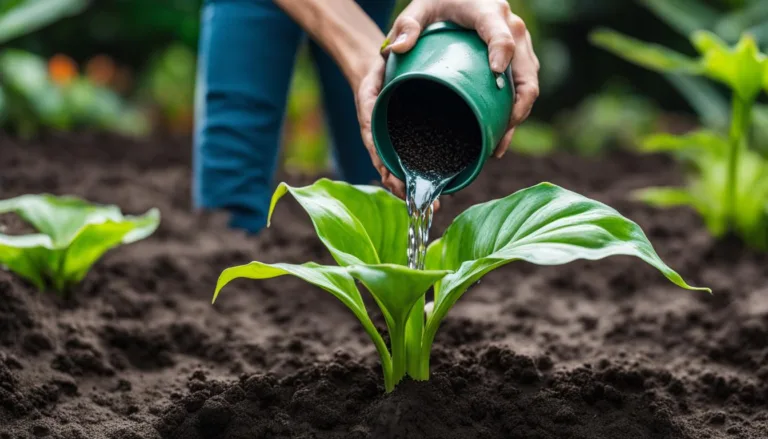
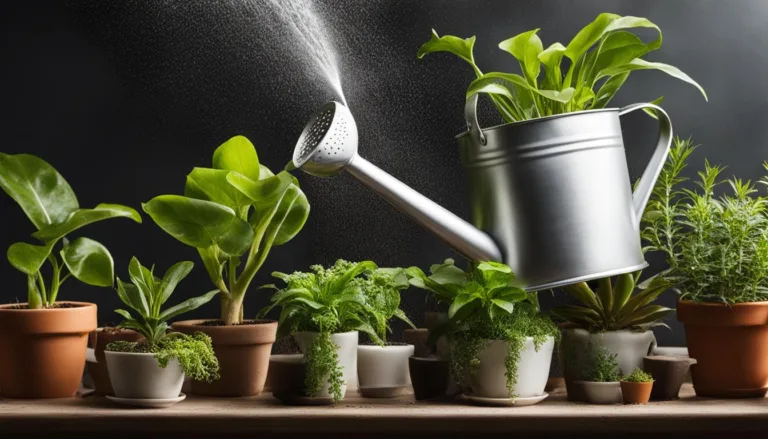
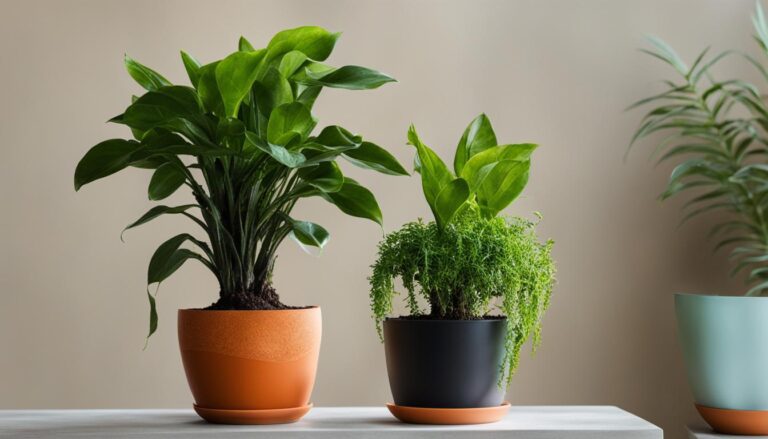
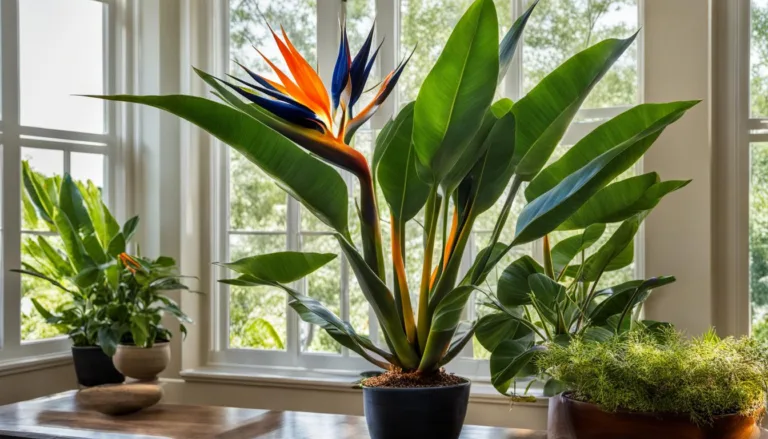
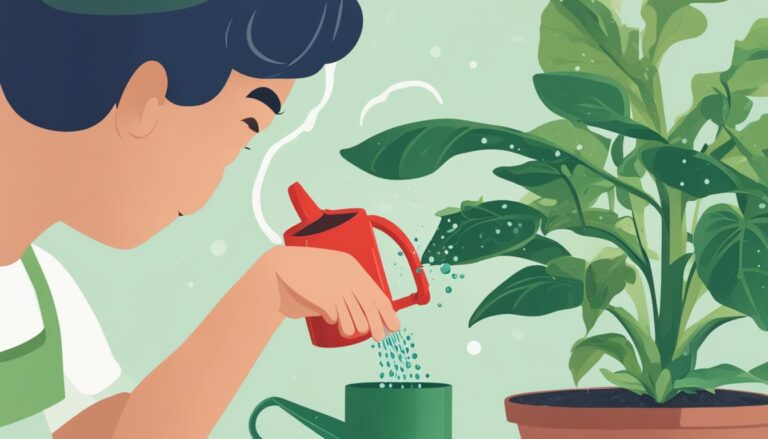
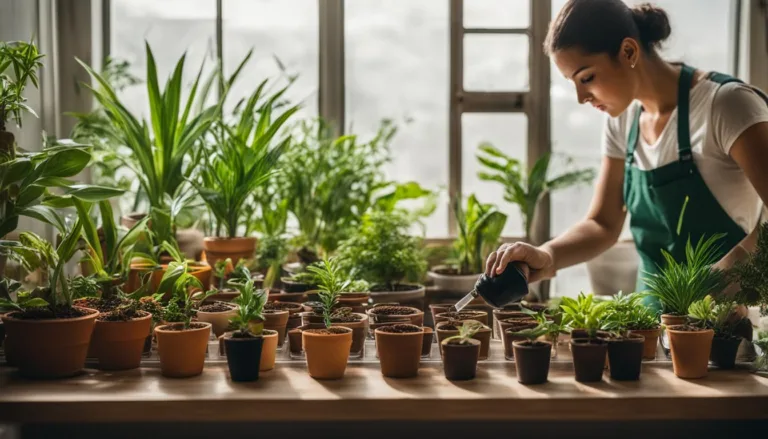
Someone has truly contributed to creating remarkable content. I want to mention that this is the first time I have visited your website, and I am impressed by the research you conducted to create this exceptional article. Great work!